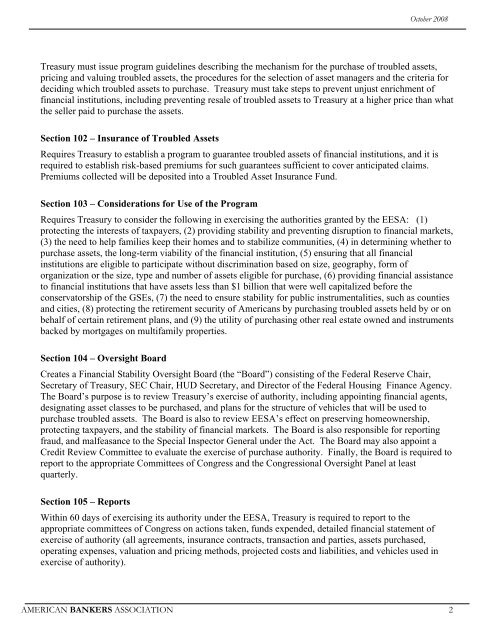Download Conference Presentations - Mortgage Lending Industry ...
Download Conference Presentations - Mortgage Lending Industry ...
Download Conference Presentations - Mortgage Lending Industry ...
You also want an ePaper? Increase the reach of your titles
YUMPU automatically turns print PDFs into web optimized ePapers that Google loves.
October 2008<br />
Treasury must issue program guidelines describing the mechanism for the purchase of troubled assets,<br />
pricing and valuing troubled assets, the procedures for the selection of asset managers and the criteria for<br />
deciding which troubled assets to purchase. Treasury must take steps to prevent unjust enrichment of<br />
financial institutions, including preventing resale of troubled assets to Treasury at a higher price than what<br />
the seller paid to purchase the assets.<br />
Section 102 – Insurance of Troubled Assets<br />
Requires Treasury to establish a program to guarantee troubled assets of financial institutions, and it is<br />
required to establish risk-based premiums for such guarantees sufficient to cover anticipated claims.<br />
Premiums collected will be deposited into a Troubled Asset Insurance Fund.<br />
Section 103 – Considerations for Use of the Program<br />
Requires Treasury to consider the following in exercising the authorities granted by the EESA: (1)<br />
protecting the interests of taxpayers, (2) providing stability and preventing disruption to financial markets,<br />
(3) the need to help families keep their homes and to stabilize communities, (4) in determining whether to<br />
purchase assets, the long-term viability of the financial institution, (5) ensuring that all financial<br />
institutions are eligible to participate without discrimination based on size, geography, form of<br />
organization or the size, type and number of assets eligible for purchase, (6) providing financial assistance<br />
to financial institutions that have assets less than $1 billion that were well capitalized before the<br />
conservatorship of the GSEs, (7) the need to ensure stability for public instrumentalities, such as counties<br />
and cities, (8) protecting the retirement security of Americans by purchasing troubled assets held by or on<br />
behalf of certain retirement plans, and (9) the utility of purchasing other real estate owned and instruments<br />
backed by mortgages on multifamily properties.<br />
Section 104 – Oversight Board<br />
Creates a Financial Stability Oversight Board (the “Board”) consisting of the Federal Reserve Chair,<br />
Secretary of Treasury, SEC Chair, HUD Secretary, and Director of the Federal Housing Finance Agency.<br />
The Board’s purpose is to review Treasury’s exercise of authority, including appointing financial agents,<br />
designating asset classes to be purchased, and plans for the structure of vehicles that will be used to<br />
purchase troubled assets. The Board is also to review EESA’s effect on preserving homeownership,<br />
protecting taxpayers, and the stability of financial markets. The Board is also responsible for reporting<br />
fraud, and malfeasance to the Special Inspector General under the Act. The Board may also appoint a<br />
Credit Review Committee to evaluate the exercise of purchase authority. Finally, the Board is required to<br />
report to the appropriate Committees of Congress and the Congressional Oversight Panel at least<br />
quarterly.<br />
Section 105 – Reports<br />
Within 60 days of exercising its authority under the EESA, Treasury is required to report to the<br />
appropriate committees of Congress on actions taken, funds expended, detailed financial statement of<br />
exercise of authority (all agreements, insurance contracts, transaction and parties, assets purchased,<br />
operating expenses, valuation and pricing methods, projected costs and liabilities, and vehicles used in<br />
exercise of authority).<br />
AMERICAN BANKERS ASSOCIATION 2


